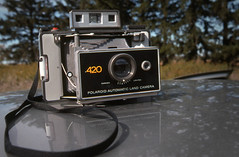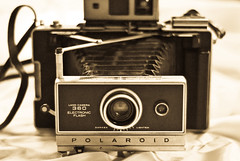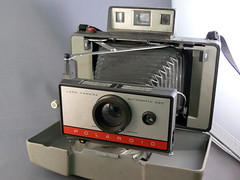Difference between revisions of "Polaroid 100-400 series"
(added z finder rev 1 and 2 photo) |
(added film list, mostly from my previous wikipedia additions in 2009/2010, was based on polaroid year end reports and catalogs.) |
||
| Line 161: | Line 161: | ||
* #1952 Portrait Kit for [[Polaroid Land Camera 195|195]] | * #1952 Portrait Kit for [[Polaroid Land Camera 195|195]] | ||
* #1951 Close-Up Kit for [[Polaroid Land Camera 195|195]] | * #1951 Close-Up Kit for [[Polaroid Land Camera 195|195]] | ||
| + | |||
| + | == Film == | ||
| + | * Type 64T, ISO 64, color, tungsten | ||
| + | * Type 084, ISO 3000, black and white | ||
| + | * Type 100, Chocolate Film, ISO 80, brownish tone film, sold by [[Polapremium|unsaleable]] | ||
| + | * Type 100, Sepia Film, ISO 1600, sepia-tone film sold by [[Polapremium|unsaleable]] | ||
| + | * Type 100, Blue Film Silk, ISO 80, blue & white tone (matte finish) sold by [[Polapremium|unsaleable]] | ||
| + | * Type 105, ISO 75 print, ISO 32 negative, black and white with negative (renamed as 665 in 1977) | ||
| + | * Type 107, ISO 3000, black and white | ||
| + | * Type 107C, ISO 3000, black and white (coaterless) | ||
| + | * Type 108, ISO 75, color | ||
| + | * Type 108, ISO 80, color (Polacolor 2, replaced by 669 in 2001) | ||
| + | * Type 125i, ISO 125, color (passport and document) | ||
| + | * Type 125i Silk, ISO 125, color (passport and document, matte finish) | ||
| + | * Type 606, ISO 200, sepia tone | ||
| + | * Type 611, ISO 200, black and white, low contrast for photographing video displays | ||
| + | * Type 612, ISO 20000, black and white, high-speed (high contrast for photographing oscilloscope traces) | ||
| + | * Type 661, ISO 80, color (special program film not for retail sale) | ||
| + | * Type 663, ISO 800, black and white | ||
| + | * Type 664, ISO 100, black and white | ||
| + | * Type 665, PN film; ISO 80 print, ISO 32 negative, black and white (reusable negative) | ||
| + | * Type 667, ISO 3000, black and white | ||
| + | * Type 668, ISO 75, color | ||
| + | * Type 669, ISO 80, color | ||
| + | * Type 669 Silk, ISO 80, color (matte finish) | ||
| + | * Type 672, ISO 400, black and white | ||
| + | * Type 679, ISO 100, color (replace by 690) | ||
| + | * Type 679 Silk, ISO 100, color (matte finish) | ||
| + | * Type 681, ISO 80, color, plastic base print | ||
| + | * Type 689, ISO 100, color (ProVivid) | ||
| + | * Type 690, ISO 125, color (replaced by newer 690 ISO 100) | ||
| + | * Type 690, ISO 100, color | ||
| + | * Type 691, ISO 80, color, (transparent film) | ||
| + | * ID-UV 100, ISO 100, color, ultra violet security imprint (passport, documents) | ||
| + | * ID-UV, ISO 80, color, ultra violet security imprint (passport, documents) | ||
| + | * Studio Polaroid, ISO 125, color (passport and document, replaced by 125i) | ||
== Links == | == Links == | ||
* [http://www.rwhirled.com/landlist/landhome.htm The Land List] - An Ongoing Project in Cataloging Polaroid Cameras | * [http://www.rwhirled.com/landlist/landhome.htm The Land List] - An Ongoing Project in Cataloging Polaroid Cameras | ||
Revision as of 17:27, 18 August 2011
| Models 420, 360 and 220 | ||||||||
|
|
| ||||||
This series of Polaroid cameras, starting with the Automatic Land Camera 100 and finishing at the Automatic Land Camera 450, all share a common set of features:
- Folding bellows
- Automatic exposure, with an external 'Electric Eye' lightmeter beside the lens
- Designed for Polaroid 100-series Packfilm (3¼×4¼-inch peel-apart instant film)
There is a very large variety within this vast range of essentially similar folding Polaroid models. The best 'standard' models are the 100, 250, 350, and 450 variants of the line.
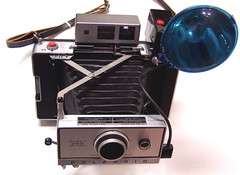
|
| Model 350 with external flash #268 image by Erich Z (Image rights) |
These feature a coupled rangefinder designed by the German firm Zeiss Ikon, rigid metal bodies and 3 element glass lenses. Most other models, such as the 103, 220 or 430 have a much cheaper build quality and features including plastic lenses, rigid viewfinders, moulded plastic bodies and many lack a tripod socket.
All these cameras produce 7.2×9.5cm prints on Polaroid 100-series packfilm, and the more expensively produced models can be capable of very good results. Many accessories were made for these cameras including, but not limited to, portrait kits, close-up kits, and electric external flashes.
A few models to be aware of are the 180, 185, 190, and 195 cameras. These professional-model Polaroid Land Cameras are among the best cameras Polaroid has ever produced, and are vastly superior to the rest of the 100-400 line as they include much faster glass lenses, fully mechanical leaf shutters, and manual exposure functionality. These models lack the built-in lightmeter the other models use to calculate exposure, and are capable of excellent results, on par with the best professional Polaroid cameras ever made - like the 600 SE.
Viewfinder & Rangefinder variants
There are several main types of view and range finder used throughout the folding land camera series, the most common being a two-window split system (as featured on the Automatic 100) whereby the user first makes focus using a small window with a circular (or, more commonly, square) shifting ranged image, and then moves the eye to a larger non-parallax corrected viewfinder with marked frame-lines for composing the shot.
This type of viewfinder was on all the very early models in the series, and continued to be used on many of the mid- and low-tier models over the life cycle of the folding packfilm camera series. Both folding and non-folding models of this viewfinder type exist; the folding type is more common on early models with higher quality lenses.
The second, and one of the more uncommon types of viewfinder used was a single window non-rangefinder variant. This type of viewfinder was used on the 104, and used a type of zone-focusing system, with subject distance selectable within the viewfinder, and two vertically travelling lines designed to be used to mark the top of a subject's forehead and their chin, to ensure correct focusing for portraiture.
This zone-focusing viewfinder also features parallax-corrected marks for judging correct subject framing at different focal distances. In the instruction manual for the 104, Polaroid includes several illustrated tips on how to ensure correct use of the focusing system on varied subjects. This viewfinder type is non-folding, and so camera models with this type of viewfinder have a slightly different case design to those with folding optics.
The third type of viewfinder common in the series is that used on the 250, 350 and other 3-element glass lens models: a high quality Zeiss-Ikon designed, single-window, parallax-corrected combination range and viewfinder.

|
| Zeiss Ikon single-window rangefinder-viewfinder image by Steve Harwood (Image rights) |
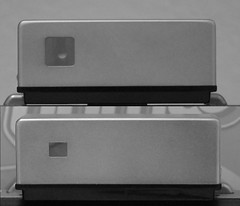
|
| Zeiss finders Top: Rev 1; Bottom: Rev 2 image by joanseda (Image rights) |
Models
- Polaroid Land Camera Automatic 100 (1963-1966)
- Polaroid Land Camera Automatic 101 (1964-1967)
- Polaroid Land Camera Automatic 102
- Polaroid Land Camera Automatic 103 (1965-1967)
- Polaroid Land Camera Automatic 104 (1965-1966)
- Polaroid Land Camera Automatic 210 (1967-1969)
- Polaroid Land Camera Automatic 220 (1967-1969)
- Polaroid Land Camera Automatic 225
- Polaroid Land Camera Automatic 230 (1967-1969)
- Polaroid Land Camera Automatic 240 (1967-1970)
- Polaroid Land Camera Automatic 250 (1967-1969)
- Polaroid Land Camera Automatic 315
- Polaroid Land Camera Automatic 320 (1969-1971)
- Polaroid Land Camera Automatic 330 (1969-1971)

|
| Model 350 image by inkyfingerz (Image rights) |
- Polaroid Land Camera Automatic 340 (1969-1971)
- Polaroid Land Camera Automatic 350 (1969-1971)
- Polaroid Land Camera Automatic 355
- Polaroid Land Camera 360 Electronic Flash (1969-1972)
- Polaroid Land Camera Automatic 420 (1972-1977)
- Polaroid Land Camera Automatic 430 (1971-1977)
- Polaroid Land Camera Automatic 440 (1971-1977)
- Polaroid Land Camera Automatic 450 (1971-1975)
Manual cameras with aperture and shutter dial on lens
- Polaroid Land Camera 180 (1965-1969) - Zeiss viewfinder, Tominon 114mm f4.5 lens
- Polaroid Land Camera 190 - Zeiss vf, Tominon 114mm f3.8 lens.
- Polaroid Land Camera 195 - 2 window viewfinder, Tominon 114mm f3.8 lens.
- Polaroid Land Camera 185 - Zeiss vewifinder, Mamiya Sekor 127mm f5.6 lens
- Polaroid Land Camera 185 (2000) - Polaroid Japan, rigid finder, Tominon 114mm f/F4.5 lens
accessories
- #126 Development timer
- #127 Development time
- #128 Development timer
- #191 Cable Release
- #192 Self timer
- #193 Cold Clip
- #268 Flashgun
- #280 Flashgun
- #471 Portrait Kit
- #473 Close-Up Kit
- #490 Flashgun
- #516 Cloud Filter
- #541 Portrait Kit
- #543 Close-Up Kit for 430 and 440
- #561 Portrait Kit for 450
- #563 Close-Up Kit for 450
- #581 Portrait Kit
- #581A Portrait Kit
- #583 Close-Up Kit
- #583 Close-Up Kit
- #583A Close-Up Kit
- #585 UV Filter
- #591 Portrait Kit for 180
- #593 Close-Up Kit for 180
- #595 Filter Kit with lens shade
- #596 Orange Filter
- #597 UV Filter
- #628 Exposure meter
- #1952 Portrait Kit for 195
- #1951 Close-Up Kit for 195
Film
- Type 64T, ISO 64, color, tungsten
- Type 084, ISO 3000, black and white
- Type 100, Chocolate Film, ISO 80, brownish tone film, sold by unsaleable
- Type 100, Sepia Film, ISO 1600, sepia-tone film sold by unsaleable
- Type 100, Blue Film Silk, ISO 80, blue & white tone (matte finish) sold by unsaleable
- Type 105, ISO 75 print, ISO 32 negative, black and white with negative (renamed as 665 in 1977)
- Type 107, ISO 3000, black and white
- Type 107C, ISO 3000, black and white (coaterless)
- Type 108, ISO 75, color
- Type 108, ISO 80, color (Polacolor 2, replaced by 669 in 2001)
- Type 125i, ISO 125, color (passport and document)
- Type 125i Silk, ISO 125, color (passport and document, matte finish)
- Type 606, ISO 200, sepia tone
- Type 611, ISO 200, black and white, low contrast for photographing video displays
- Type 612, ISO 20000, black and white, high-speed (high contrast for photographing oscilloscope traces)
- Type 661, ISO 80, color (special program film not for retail sale)
- Type 663, ISO 800, black and white
- Type 664, ISO 100, black and white
- Type 665, PN film; ISO 80 print, ISO 32 negative, black and white (reusable negative)
- Type 667, ISO 3000, black and white
- Type 668, ISO 75, color
- Type 669, ISO 80, color
- Type 669 Silk, ISO 80, color (matte finish)
- Type 672, ISO 400, black and white
- Type 679, ISO 100, color (replace by 690)
- Type 679 Silk, ISO 100, color (matte finish)
- Type 681, ISO 80, color, plastic base print
- Type 689, ISO 100, color (ProVivid)
- Type 690, ISO 125, color (replaced by newer 690 ISO 100)
- Type 690, ISO 100, color
- Type 691, ISO 80, color, (transparent film)
- ID-UV 100, ISO 100, color, ultra violet security imprint (passport, documents)
- ID-UV, ISO 80, color, ultra violet security imprint (passport, documents)
- Studio Polaroid, ISO 125, color (passport and document, replaced by 125i)
Links
- The Land List - An Ongoing Project in Cataloging Polaroid Cameras
- Polaroid.com - Polaroid's User Guide for folding packfilm cameras (.pdf)
- Polaroid cameras and manuals on www.collection-appareils.fr by Sylvain Halgand
- 100, 101, 104, 195, 210, 225, 230, 315, 320, 330, 340, 350, 355, 440 on www.collection-appareils.fr by Sylvain Halgand
- Picture Gallery using Polaroid 100 series www.picturenoise.com
